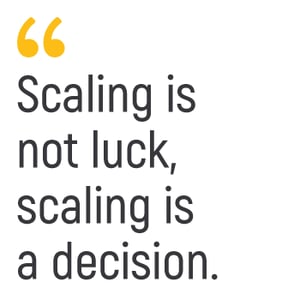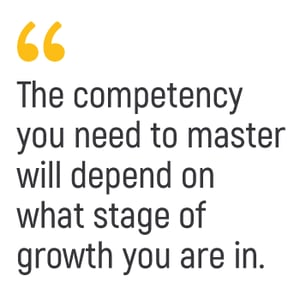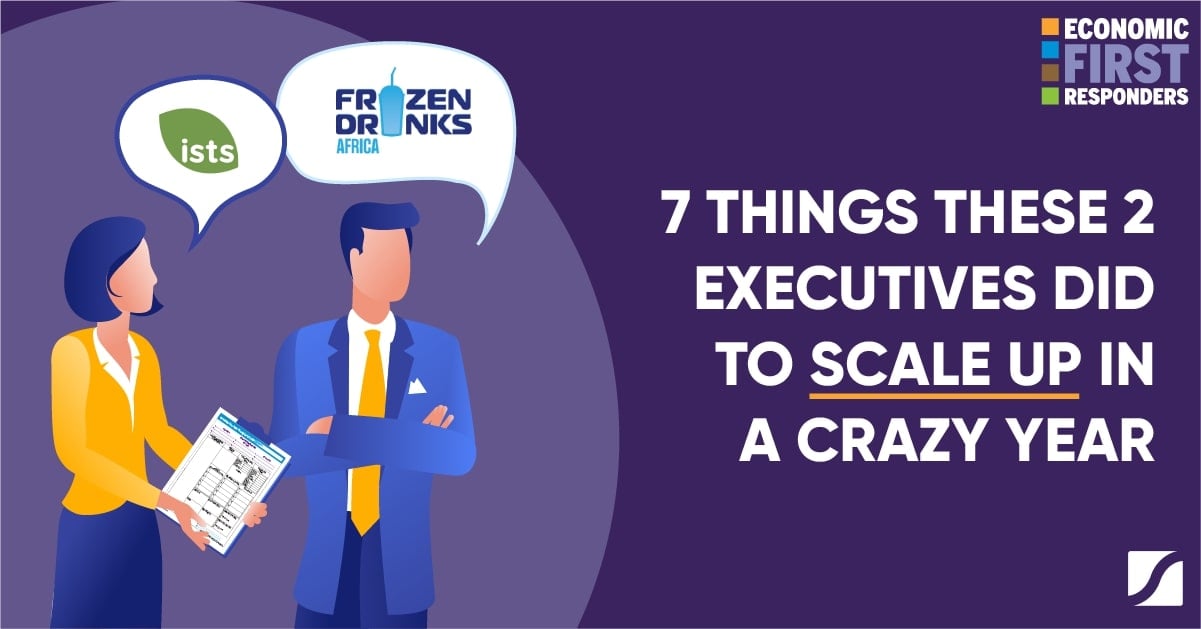Growing vs Scaling: which one are you?

Most business leaders dream of scaling their company. You’ve probably pictured yourself being an industry leader: established in different locations, serving a global market and having your brand being recognized as the go-to solution for your customers.
However, in reality, less than 1% of the companies that start up, actually make it. The ones that do, they don’t set out to grow - they build their company for scale.
Let me be straightforward: scaling is not luck, scaling is a decision.
I oftentimes hear from my clients that just like every other big milestone in their lives, they remember the day and exact moment in which they made that decision. And I do to.

It was a Sunday evening, a few years back, after putting my kids to bed. Together with my co-founder Juan Gonzalez, we got some beers, a whiteboard, and brainstormed about what we wanted our company to become in 5-10 years. We made a checklist with all the key elements we needed, and compared these with how the company was at that moment: cashflow, team, infrastructure etc.
Even though we were extremely excited about what we were envisioning and the path we had designed, we had this bittersweet, but fundamentally necessary, feeling: the company was not yet at the level we thought was necessary to scale. Before I tell you the rest of the story, we need to cover some key concepts about scale.
Let's define scale
When your business is growing, you’re increasing revenue, increasing market share, and increasing people. Meanwhile, your expenses tend to grow at the same rate (if not more) because growth sucks cash! That’s the external reality.
The internal reality is that stress levels and the drama of the daily operations with your team are both through the roof. All this leads to less and less time spent with your family and other things that really matter. A lot of the time, growing a business sucks.
Scaling is a whole other story. When you’re scaling, your revenue is growing at a much faster rate than your expenses, giving you the cash and resources to help you fund and support the increased business. You’ll have the opportunity to hire the right team, invest in tools and resources you couldn’t afford before, and reduce operating drama. When you’re scaling, you can have your life back!
My rule of thumb for what scaling is:
When you scale, you are growing at 2x the industry average but your expenses year over year remain stable.
Note: Companies grow in stages. Learn what stage you’re in.
Why don't most companies scale?
.png?width=600&name=BLOG%20%231%20-%20Image%201%20(Valley%20of%20Death).png)
Let’s take the United States as an example - there are currently around 28 million companies, and 96% of these businesses are stuck! Out of the 28 million, only 4% are making over $1million in revenue per year, less than 1% are making over $10million, and only 17,000 are making over $50 million.
As the graph suggests, companies hit roadblocks when trying to move to the next level, and very few manage to survive. I like to call these roadblocks the “valleys of death”.
When you’re trying to grow, and you find yourself in a valley of death, you’ll need master new competencies. Remember, what got you here, will not get you to the next level. And the competency you need to master will depend on what stage of growth you are in.
On a very personal note, every time we’re about to move to the next stage as a company, my wife and I have “the talk”. She notices I’m working more hours, spending less time with the family and am visibly tired. One way or another, scaling wears you down, and you’ll want to get a support system that understands you, understands your vision, and is always there for you.

Back to that Sunday evening, this was what Juan and I knew we had ahead of us: if we were going to scale our company, we had to work diligently to check off all the items on our checklist. Hiring for specific roles, plus acquiring tools and competencies as a team and as leaders was crucial to survive the valley of death we had ahead of us.
Whenever that checklist was completed, we knew we’d be ready to face the valley of death, and move the company to the next stage. But what stage were we at?
The 4 stages all successful companies go through
.png?width=400&name=BLOG-%231---Image-2-(IV-Stages).png)
There are 4 stages that all companies go through as they scale. Just like human beings - who need different food, different care, and have different goals – companies go through growth stages.
By the time Juan and I took the decision to scale, we were at Stage II.
At the end of this post, you’ll find a simple guide that helps you navigate the 4 stages, but a quick way to identify which stage your company is in, is the number of employees.
.png?width=100&name=BLOG-%231---Image-3-(Stage-I).png)
Stage I - Start Up
Usually 1-5 employees. You, the leader, are everything. You are the center of the company, and end up being a jack of all trades.
At this stage, your focus is product development and your priority is to validate your business model. Most companies that succeed end up selling a product or service very different than what the founders thought the market needed at first.
.png?width=100&name=BLOG-%231---Image-4-(Stage-II).png)
Stage II- Grow Up
Usually 6-15 employees. You are now a more focused leader. The company now depends on other people executing their tasks.
At this stage, your focus is 100% on sales and your priority is hiring the right team.
Why sales? Now you have bills and salaries to pay. It’s both humbling and scary when you first realize that you are not only responsible to serve a community of clients and partners, but also that your team and their families depend on the success (sales) of your business.
Why hiring the right team? Now you’re delegating and you no longer have direct influence on the product you’re selling, so you need to get the right team.
.png?width=100&name=BLOG-%231---Image-5-(Stage-III).png)
Stage III - Scale Up
Usually between 15-250 employees. You are a leader of leaders. Your company has validated its product and you’re aligning and simplifying processes, betting on a select number of products, and trying to 10x, 100x, or 1000x them.
Your focus is defining your place in the industry and your priority is to scale. Previously, your competition didn’t even know who you were. Now, you have the chance to start challenging their place in the market by inserting yourself. You will only move to the next stage if you set your company for scale in terms of infrastructure, people and processes.
.png?width=100&name=BLOG-%231---Image-6-(Stage-IV).png)
Stage IV- Industry Domination
Usually over 250 employees. You start fighting a battle to win the market and you control a significant percentage of it.
Your focus is dominating the industry, and your priority is constantly reinventing your business. Usually, when leaders get to this stage, they develop a sense of accomplishment and everything seems to indicate that if they keep on doing what they are doing, they’ll maintain their status.
This is how, slowly but surely, companies lose their strength and eventually are put out of business by a newer, smaller and faster player in the market.
How to navigate the 4 stages of growth?
The first step is to identify in what stage you’re in.
Secondly, you need to apply your new competencies or growth dynamics (focus, priorities and abilities) for that specific stage.
About 6 months after Juan and I made the decision to scale, I looked at our checklist and immediately had to call him. We were ready. All the hard work the team had put in to set us up to scale was finally showing results!
I’ve written a guide that teaches you how to navigate the 4 stages of growth and have the company you’ve always wanted. Following these steps, you can build your company for scale, avoid stress and drama, and have a life!




